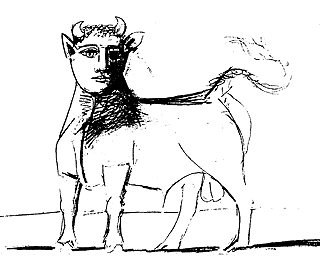https://www.austinchronicle.com/arts/1997-01-17/525995/
Local Palette
Lithographs
January 17, 1997, Arts
Pablo Picasso
Ruth Borinstein Gallery
on display until sold
 Bull With Human Head by Pablo Picasso, 1937 |
Now, believe it or not, we have a little bit of Guernica in Austin. Abbie and Ruth Borinstein, owners of Ruth Borinstein Gallery, recently completed their annual art excursion to Europe, including a stay in Venice, Italy. While there, they encountered a special show of graphics by Picasso, including a complete portfolio of lithographs made from the original sketches Picasso executed in the making of Guernica. The couple bought the portfolio, which contains 42 lithographs -- an incredible find for any Picasso lover, even more incredible for a Picasso lover living in Austin, a town not exactly known for its collection of European masters.
Master artists are the Borinsteins' specialty. Lithographs by a dizzying array of artists, including Chagall, Miró, and Cassatt, line the walls of the tiny space in Westlake Hills. The Borinsteins have been making the Europe/Austin trek for more than 15 years, bringing back a bit of historical European culture every time -- though few pieces can claim to have stirred as much political and cultural fervor as Guernica.
Sculptures
Charles Umlauf
Umlauf Sculpture Garden
ongoing exhibit
Unless you've been to the Umlauf Sculpture Garden in the past week, it has been too long since your last visit. My arts assignment to you is to visit the garden and museum and, upon arrival, kneel down on the leaf-strewn ground and kiss it, giving thanks for this wonderful mini-paradise within the city.
Indeed, we are a lucky lot to have this massive collection of sculptures nestled in our midst. Charles Umlauf was not only an exceptionally gifted artist, he was, or so his sculpture suggests, a man of great sensitivity and passion.
Umlauf and his wife, Angeline, donated their home, grounds, and more than 250 pieces of Umlauf's work to the city of Austin in 1985, and since then it has been transformed into a museum and garden, showcasing pieces spanning more than a half-century of the renowned sculptor's career. Yet Umlauf Sculpture Garden is much more than a garden or a sculpture exhibit; it's a walk through a land of immortalized souls, frozen in time in wood, terra cotta, stone, marble, bronze, and alabaster. It's a little utopia, inhabited by lovers, bathers, saints, and refugees, many so realistic and full of life, you'd think Medusa was responsible for them.
One of the most emotional pieces is the achingly sad "War Mother," a mother, consumed with desperation, enveloping her frightened, wide-eyed child. Umlauf made the smooth stone work in reaction to the war while living in Chicago in 1939. The piece generated vast national attention, which alerted UT's art department to the young artist's work, providing the impetus for Umlauf's move to Austin in 1941. Fortunately for us, Austin remained his home until his death in 1994.
On January 18, the museum will offer dollar day; consider it a day of beauty
for a buck.
-- Cari Marshall
Copyright © 2024 Austin Chronicle Corporation. All rights reserved.
